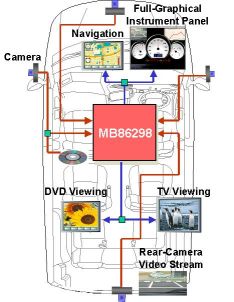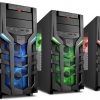 Fujitsu Microelectronics Asia Pte Ltd announced the launch of a new graphics controller System-on-Chip (SoC) for automotive infotainment systems, such as next-generation car navigation and digital dashboards. The new controller, the MB86298, offers the highest-class graphics capability for embedded systems, as well as an industry first of providing output to up to 4 displays, and up to 4 video inputs.
Fujitsu Microelectronics Asia Pte Ltd announced the launch of a new graphics controller System-on-Chip (SoC) for automotive infotainment systems, such as next-generation car navigation and digital dashboards. The new controller, the MB86298, offers the highest-class graphics capability for embedded systems, as well as an industry first of providing output to up to 4 displays, and up to 4 video inputs.
Featuring superior input and output functionality, the MB86298 can process 4 inputted video streams while outputting video to 4 displays. The inputted videos can be modified, synthesized together, and put on 3-D graphics surfaces within a single screen. Subsequently, with 4 cameras mounted on all sides of the automobile (front, back, left, and right), it is possible to freely choose the desired viewpoint and form for display. In addition, the controller’s industry-leading capabilities enable display of 8 layers and inter-layer blends (*1), where each information stream is processed separately so that users can selectively change the information screen to be displayed, as well as being able to synthesize the information streams together smoothly and display them.

Figure 1: Example of the MB86298 controller at the nexus of an in-vehicle infotainment system

Figure 2. Graphics Controller SoC (Unit:cm)
In recent years, the amount of electronics in automobiles has continued to rise, providing information and entertainment to the driver and passengers, bringing about increased safety, more comfort and reduced environmental impact to the driving experience: for example, car navigation systems that change with real-time traffic information, video from blind-spot cameras, streaming TV and DVD video to passenger seat displays, and so-called “eco-drive” functions which support low fuel consumption by displaying information of the car’s running condition.
There are increasing needs to simultaneously show several video and image streams to several displays within the automobile, such as showing different images to the driver’s seat and front passenger seat (dual-view LCD displays), and viewing TV and DVDs on the rear seat displays. At the same time, automotive infotainment systems that capture and display information of the vehicle’s periphery from several cameras mounted on the vehicle have emerged. Subsequently, such automotive systems demand high-performance graphics SoCs that can process in real-time several different images and video streams, and process such large volumes of imaging data at high-speed.
On a single chip, this new MB86298 controller contains the necessary functions demanded for next- generation automotive infotainment systems, providing high-speed video and graphics processing to handle an industry first of 4 video inputs, and output to 4 displays. This controller can not only realize systems which show navigation images to the driver – while showing TV and videos to the passenger displays – as previously possible, but can also process and display the dashboard instrument cluster in 3-D graphics, including meter needles. In Addition, the controller can handle the inputs from 4 cameras (front, back, left, right) mounted on the vehicle and process them and synthesize them together in real-time. Also, for car navigation 3-D mapping, this controller can output to high-resolution 1600 x 600 pixel displays to bring out rich image detail, not just of the roads, but of surrounding buildings and scenery.
Key Features
-
- Allows 4 video capture inputs and output to 4 displays
To each of 2 display ports, it is possible to output 2 screen images – for each screen image, 8 levels and inter-layer blends can be displayed. Therefore, on top of a map of the surroundings, explanation notes can be overlaid, as well as an overlay of images of the surroundings from the vehicle cameras. In such cases, the outline of cars is extracted and overlaid, so it is like the overlaid image blends into the background image of the surroundings. Dither (*2) and gamma (*3) correction functions are included, offering high-quality imaging on displays of varying resolutions and color characteristics. Furthermore, the 4 video inputs enable various video inputs to undergo simultaneous processing. Inputs up to resolutions of 1280 x 720 pixels can be handled, and functions are included for enlargement/reduction, and conversion of interlace format – suitable for motion – to progressive format (*4) which has less noise. - Industry-leading high-speed, high-resolution rendering
It features top-class rendering performance in its industry with 400 million pixels per second, providing real-life maps with minute detail and smooth rendering. As graphics memory, 800MHz DDR2 SDRAM is used – with a maximum data rate of 6.4 gigabytes per second (6.4Gbps), it is possible to display several layers of display data on top of each other at high resolutions. The controller also contains a unified programmable shader (*5) that is capable of operations at 17G FLOPS, which can render highly textured and detailed surfaces, such as the metallic surfaces of a car body, in life-like detail. With such high rendering performance, this controller can output in real-time to high-resolution 1600 x 600 pixel displays, to bring out rich image detail. - OpenGL® ES2.0 graphics acceleration
The MB86298 graphics controller contains an acceleration function for OpenGL® ES2.0 (*6), making it simpler to construct an in-vehicle entertainment environment. Also, Fujitsu Microelectronics plans to provide OpenVGTM1.0 support for smooth enlargement/reduction of characters and straight or curved lines. -
Glossary and Notes
1. Inter-layer blends: A function that allows several screen images to be mixed together to form one screen image.
- Allows 4 video capture inputs and output to 4 displays
2. Dither function: A function that can produce intermediate colors on displays that have few colors.
3. Gamma function: A function that corrects color data to match the display characteristics.
4. Conversion of interlace format – suitable for motion – to progressive format: A function that improves picture quality when converting from interface format to progressive format.
5. Programmable shader: A function used in 3-D graphics that can render objects to be real-life looking by allowing the user to freely program to match the image they are trying to create, rather than the fixed shading processing previously used.
6. OpenGL ES: A subset of OpenGL for embedded devices. OpenGL is a standard program and library to handle graphics on computers.
Appendix
Key specifications of the MB86298 graphics controller
| Process Technology | 90nm CMOS |
| Operating Voltage | Internal: 1.2±0.1V, I/O: 3.3±0.3V DDR2 memory: 1.8±0.1V |
| Operating Frequency (max.) | 266MHz, DDR2 800MHz |
| Peripheral I/O | PCI-Express, I2C(Master), GPIO, JTAG |
| Operating Temperature Range | -40° ~ 85° |
| Power Consumption | 4.0W (TYP) |
| Package | TEBGA 543 pin |
| Application | Navigation, Cluster (car dashboard), Car center console etc. |
[Development Environment]
Fujitsu Microelectronics plans to support the following development environment:
-
- MB86298 Evaluation Board
In the form of a PCI Express card, can connect to PCI Express bus of a PC with Microsoft® Windows® XP Professional operating system. - OpenGL® ES2.0 Library With the use of the OpenGL ES, the standard graphics API optimized for embedded applications, embedded systems with real 3-D graphics can be realized.
- Graphics Controller Access Library
A set of drivers will be provided to access simply the rendering peripherals such as display controller and video capture on the MB86298. - OpenVGTM 1.0 Library
With the use of this library, the functions of the MB86298 can be used to a maximum to render high- quality vector graphics
- MB86298 Evaluation Board
Source: Press Release
